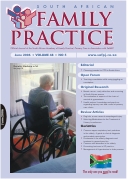Preventing fractures in the elderly in GP practice
Abstract
Osteoporosis is a common bone disorder that increases the risk of a fragility fracture. The elderly are prone to the development of osteoporosis and have an increased propensity to fall thereby increasing their risk of fractures. Fractures (especially hip fractures) in the elderly are associated with a high morbidity and mortality, and are also costly, accounting for large portions of health budgets. To prevent fractures it is therefore prudent to identify those with or at risk of osteoporosis and those at risk of falling. Although there is a lack of consensus on which individuals gain most benefit from Dual Energy X-ray Absorptiometry (DEXA) screening, the majority would concur that individuals with known risk factors for osteoporosis and those at risk of sustaining a fracture should undergo DEXA screening. After a diagnosis of osteoporosis, secondary causes should be excluded and appropriate therapy initiated. Therapy may include treatment of a secondary cause, non-pharmacologic and pharmacologic measures. Pharmacologic therapy has been shown to significantly decrease the risk of both vertebral and non-vertebral fractures. Individuals not diagnosed with osteoporosis but at increased risk of falls have been shown to derive some benefit from calcium and vitamin D supplementation, a weight-bearing exercise regimen, and refraining from smoking and alcohol abuse. SA Fam Pract 2006;48(5): 35-41)
Issue
Section
CPD
By submitting manuscripts to SAFP, authors of original articles are assigning copyright to the South African Academy of Family Physicians. Copyright of review articles are assigned to the Publisher, Medpharm Publications (Pty) Ltd, unless otherwise specified. Authors may use their own work after publication without written permission, provided they acknowledge the original source. Individuals and academic institutions may freely copy and distribute articles published in SAFP for educational and research purposes without obtaining permission.

